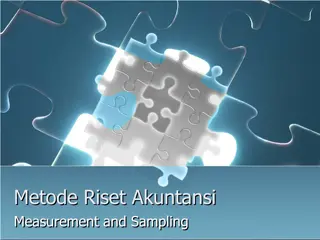Understanding Competence Measurement in Literary Translation
Exploring the concept of competence measurement in literary translation, this text delves into the ELV competence model, a five-step scheme for measurement, reliability versus validity, and the relationship between competence measurement and translation product evaluation. It discusses the importance of defining, describing, and evaluating competencies in translation practice, emphasizing the distinctions between linguistic, textual, heuristic, literary-cultural, professional, evaluative, and research competencies.
Download Presentation

Please find below an Image/Link to download the presentation.
The content on the website is provided AS IS for your information and personal use only. It may not be sold, licensed, or shared on other websites without obtaining consent from the author. Download presentation by click this link. If you encounter any issues during the download, it is possible that the publisher has removed the file from their server.
E N D
Presentation Transcript
Literary translation competence measurement Henri Bloemen & Winibert Segers Budapest 17th of October 2015
ELV (Expertisecentrum Literair Vertalen) competence model (2014) translating competence linguistic competence textual competence heuristic competence literary-cultural competence professional competence evaluative competence research competence
Five step scheme for competence measurement naming the competence and sub-competencies defining the competence and sub-competencies describing the competence and sub-competencies (competence descriptors / can-do statements) behavioral indicators (objectively observable and dichotomously scorable / the expected behavior is observable or not) development of reliable and valid measuring instruments
Reliability A test is reliable if it produces the same results, again and again, when measuring the same thing.
Example reliability Two different evaluators give the same score to a translation.
Validity A test is valid if it measures what it claims to measure.
Example validity An instrument that measures linguistic competence should not measure at the same time literary-cultural competence.
Reliability and validity Reliability is a necessary but not sufficient condition for validity.
Competence measurement and translation product evaluation Competence measurement is person-, subject-bound. What does the translator know (knowledge), can (skills) and which attitude should she/he adopt (attitude)? Translation product evaluation (target text evaluation) is product- bound. Relationship between competence and product? (Does a competent translator make good translation products? This question cannot be answered.)
Practical proposal for a literary translation competence test Disappointing results of other competence projects (legal translators, social translators) One test taken in 80 minutes (8 x 10 minutes) 10 minutes per competence The validity of the test can become compromised, if the test is too long. (The test will measure endurance and resistance to fatigue rather than literary translation competence.) Literary translation competence test French English
Model question for translating competence Une copie, si belle qu elle soit, ne peut jamais remplacer l original. The copy is so beautiful that it can never replace the original. The English translation is correct incorrect
Model question for linguistic competence Il faut arriver avant qu il ne fasse trop chaud. The ne in this sentence is a causative ne concessive ne expletive ne negative ne
Model question for textual competence Andr vient de ranger l armoire de l auberge d Am lie. Il est sale. The pronoun il refers to Am lie Andr armoire auberge
Model question for heuristic competence Zola, E. (1998). The Ladies Paradise. Oxford: Oxford University Press. On the basis of this bibliographical reference, we can conclude that Zola was the author of the English original. correct incorrect
Model question for literary-cultural competence Aujourd hui, maman est morte. Ou peut- tre hier, je ne sais pas. J ai re u un t l gramme de l asile : M re d c d e. Enterrement demain. Sentiments distingu s. Cela ne veut rien dire. C tait peut- tre hier. These sentences are the first sentences of La naus e (Jean-Paul Sartre) La vie imm diate (Paul Eluard) L tranger (Albert Camus) L invit e (Simone de Beauvoir)
Model question for professional competence A literary translator can become a member of ATLF (Association des Traducteurs Litt raires de France) CFTL (Coll ge Fran ais des Traducteurs Litt raires) FTLF (F d ration des Traducteurs Litt raires de France) SFTL (Soci t Fran aise des Traducteurs Litt raires)
Model question for evaluative competence Le petit h tel est agr able. Le propr taire est un excellent h te, tr s serviable. The small hotel is nice. The owner is an excellent, very helpful guest. Guest is a grammatical error interpretation error spelling error style error
Model question for research competence Rebuilding the Bridge at Bommel. Notes on the Limits of Translatability is an article written by James S. Holmes Roman Jakobson Ji Lev Gideon Toury























